KENYA!
Photo Safaris
Dates: TBA
2018 was our 34th Year doing Kenya Safaris
An East African Photo Safari is the experience of a lifetime, but one that often becomes a nearly annual experience for many. We’ve been doing photo safaris for thirty years, and we not only know
what we’re doing photographically to deliver the best possible images you can make, but we also offer something few others can. We also provide the story, the natural history, the reasons why something happened, or why it may happen as we wait. We are photographers, of course, but we are also naturalists, biologists by training, and we take enormous pleasure in interpreting and making sense
of the behaviors you will see.
You can go on a safari with a photo leader and take pictures, but there is no other photo safari that will provide you with the information that explains what you are seeing, that gives meaning to
your photographs and to your experience. As our participants say, it is what truly
sets us apart from all the rest.
The complete brochure has ALL the details. But here's a quick summation.
Why we are unique
Experience.
30 years leading safaris.
We know the wildlife and how best to utilize your time.
Our rotation system insures you will have the best experience possible.
You are getting two very experienced leaders for the price most tours have for only one leader, experienced or not.
Why we offer trips in the Fall
The short rainy season has fewer people.
The skies are the most varied, offering the best light for AM and PM shooting.
Predatory babies are usually present at this time.
The unpredictable gnu migration is still likely to be present.
Featuring the Best Photographic Locations
We visit five different shooting locations.
Samburu has several unique endemics found nowhere else (easily) in Kenya.
One night in Lake Nakuru since water levels have risen
and flamingos are no longer the main attraction.
We target the most interesting species in Nakuru.
We are the only operators to visit three different locations in the Masai Mara.
Transit days in the Mara are game drives- no lost shooting opportunities.
Who is this safari for
Serious photographers and naturalists.
Folks willing to spend time waiting if it is required.
Patient photographers and naturalists.
This safari is not for 'see it and go' tourists!
Our Unique Rotation System
We rotate participants through vehicles, guides, and us.
We avoid cliques.
Participants get maximum time with us as your guides.
What you can expect from us
The most productive safari possible.
Accurate, informative natural history information.
Professional help in your photography - compositions, positioning, exposure.
Our Photo Safari Highlights
Three Photographers per vehicle maximum
Photo Instruction and Guidance in the Field
Fair and Equal Rotation of Photographers
Quality Time at the Two Best Game Areas - Samburu and the Masai Mara
Quality Time and Patience - You will see all the species but
you will see and photograph behavior too.
Three Locations in the Masai Mara - The ONLY safaris covering the entire area
The Short Rainy Season - Great skies, fewer tourists, sunny mornings, soft light in the PM
Participant Photo Show - Portfolio of our participants' work on our last evening
Photo CD - The Portfolio and more on a CD after the trip
Our Interpretation and Expertise - You can rely on our knowledge and experience to help predict
behaviors and photo opportunities
Informal Lunch and Dinner Discussions on What You Saw and what it means
Driver-Guide Tip in included in the tour price
If this interests you, please read on!
No American Photographers have more field experience
leading photo safaris to East Africa.
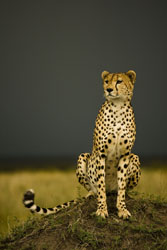

PRICES:
Dates: TBA Price: $TBA
(single supplement $ TBA)
To get the absolute most out of these safaris, consider taking one of our
Complete Digital Nature Photo Courses next summer!
PLEASE NOTE - Prices listed are based upon 10 participants.
There will be a small surcharge if the safari has fewer participants.
See below (What's Included) for the rationale and advantages.
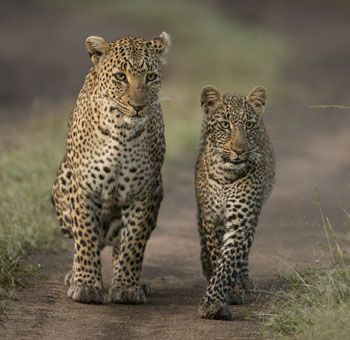
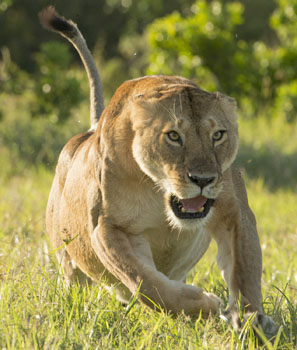
For even more information, please read any of our TRIP REPORTS which detail, day-by-day, the safaris
from that year. This will give you an excellent idea of what our trips are all about, what we see,
and perhaps most importantly, how successful these trips are!
You can read all of our Kenya Trip Reports for even more information.
Click here if you'd like to
order our Photographing on Safari video,
or
to read general photo safaris information.
Contents
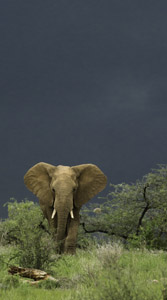
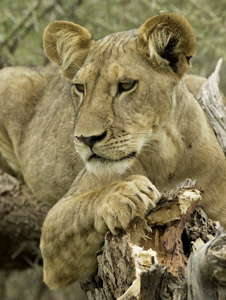

We know Africa, we know how to make a safari run smoothly, and we know the wildlife.
If you are interested in obtaining quality photographs, in seeing wildlife in-depth, in watching
behavior, and witnessing truly once-in-a-lifetime wildlife opportunities, then our safaris are for you.
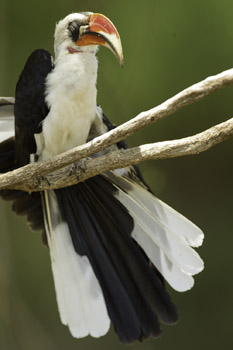
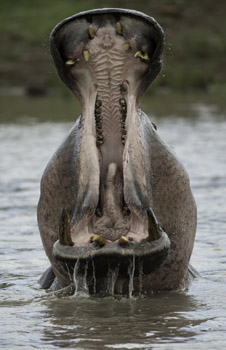
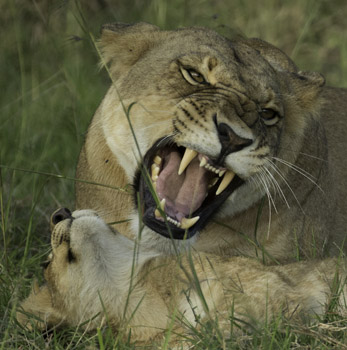
Why do we offer trips in the Fall?
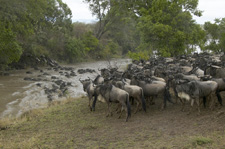 October through early December is one of the slower seasons for tourism in Kenya,
October through early December is one of the slower seasons for tourism in Kenya,
except for our safaris and other canny photographers who follow our lead.
It is still a most spectacular time of year to visit Kenya, for during this time
the wildebeest migration may be 'in', and the short rainy season usually develops
sometime during this period, giving us great cloudscapes and skies for some
of our shooting. If the migration arrives, the bountiful supply of food often
stimulates the predators into initiating a mating. Not being far-sighted, lions
revel in the abundance of food present at the time, even though the herd may be
gone by the time any young are born. Typically, the months following the
migration is the time of lion babies, even though this season can be one of
extreme stress, as the huge herds of easy game are gone.
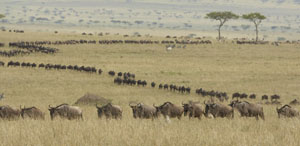 Our autumn trips usually coincide with the short rainy season - either in the middle of it, or catching either the front or back end. Why travel to Kenya if it's raining? Well, for one, the rains are short - typically they occur in the late afternoon, and they are scattered. It's entirely possible to do a game drive and have rain clouds visible at all four compass points, and yet be rainless. Rains are usually short, too, and rarely compromise a game drive.However, rains generate action! The skies in the afternoon are often magnificent, as thunderheads build up into dramatic skyscapes. Landscape images are far more interesting with a great sky. Rain induces bird nesting activity, and weavers, social weavers, and hornbills actively
Our autumn trips usually coincide with the short rainy season - either in the middle of it, or catching either the front or back end. Why travel to Kenya if it's raining? Well, for one, the rains are short - typically they occur in the late afternoon, and they are scattered. It's entirely possible to do a game drive and have rain clouds visible at all four compass points, and yet be rainless. Rains are usually short, too, and rarely compromise a game drive.However, rains generate action! The skies in the afternoon are often magnificent, as thunderheads build up into dramatic skyscapes. Landscape images are far more interesting with a great sky. Rain induces bird nesting activity, and weavers, social weavers, and hornbills actively
nest when mud or new grasses are available.
Typically, mornings begin cloud free and brilliant, with clouds building during the day. This provides photographers
with the opportunity to shoot subjects in two lighting conditions - in bright light in the AM, and, perhaps, overcast conditions in the afternoon. As one would expect, along the equator the heat builds up through the day and, on a cloudless day, it can get rather warm by late afternoon. Clouds cool things off, so nocturnal animals, like leopards,
are much more likely to be active on a cool day than on a hot, sunny afternoon. Another perk for this season!
 We'll be visiting five locations on this safari. Samburu, in the arid, semi-desert area of north central Kenya, Lake Nakuru, mid-way on our journey from one
We'll be visiting five locations on this safari. Samburu, in the arid, semi-desert area of north central Kenya, Lake Nakuru, mid-way on our journey from one
reserve to the other, and three locations in the Masai Mara.
Samburu at this time of year should be filled with bird life. The short rains
should have some influence on the landscape and with luck the vegetation
will be morphing from dry season brown to verdant short-rain green.
Bird activity can be one of your trip highlights here! Of course, the usual
wildlife - elephants, the herd animals and ungulates, and the predators will
be in their normal numbers, but the bird life can be outstanding.
It is too long a drive to travel from Samburu to the Mara in a single day.
We'll be overnighting at Lake Nakuru, arriving in time for a late lunch. After
lunch we'll do an afternoon game drive, and another all-morning game drive
where we'll concentrate on the incredible flamingos.
To sum up, our focus of this trip will include the following:
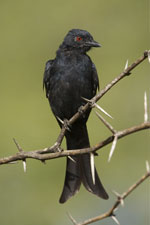
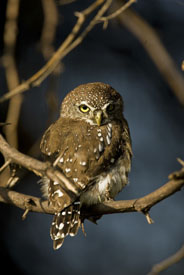
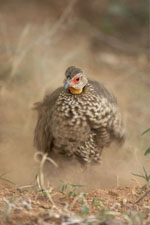
Bird life in Samburu - One of the most surprising aspects to many safari photographers is the variety
of bird life available. Samburu is the premiere bird location, with a large variety of birds of prey, as well as diverse other birds, and many of the tracks run through vegetation that is no higher than our vehicles' roofs, so eye-level shooting is easy.
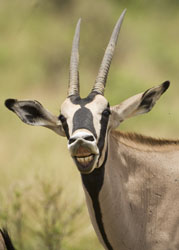
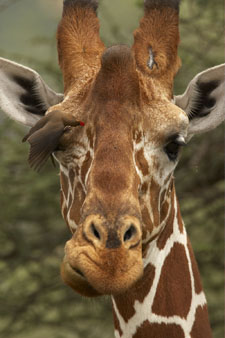
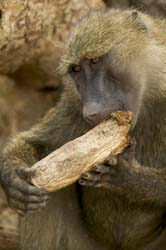

Mammals in Samburu -
Several endemic mammals are found nowhere else (see our itenerary), including the upright-standing gerenuk,
the tiny dik-dik, the unicorn-like oryx, and the reticulated giraffe.
We'll have one of our best chances of photographing a leopard here.


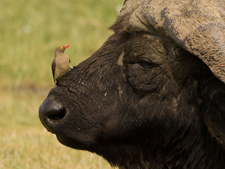
Wildlife in Nakuru - although we'll only be spending a short period of time here,
we'll have ample opportunity for photographing the species we normally encounter here, including White Rhinos, Black Rhinos,and Rothschild Giraffes, .
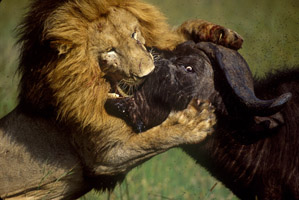
Predatory Action in the Mara - Lions and Cheetahs are likely to be hunting, and if there is any
possibility of photographing incredible action, we will do it.
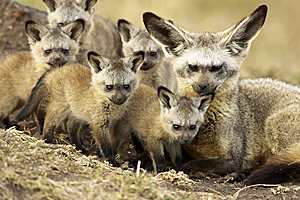
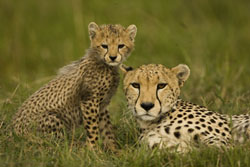
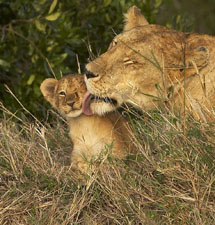
Baby Predators in the Mara - We usually get lion cubs and cheetah cubs.
One of the true advantages to our safaris, and this is truly unique, is our staying
at three different, widely spaced lodges in the Masai Mara. By doing so,
we can cover virtually the entire area, which is simply not possible if you are based at
only one location.

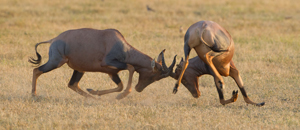
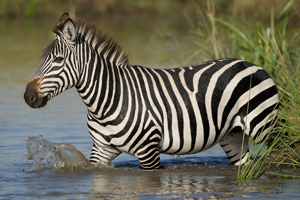
The Usual Stars - of course, we'll also be photographing all the mammals we normally encounter.


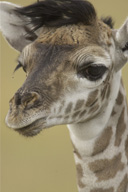
Featuring the Best Photographic Locations in Kenya
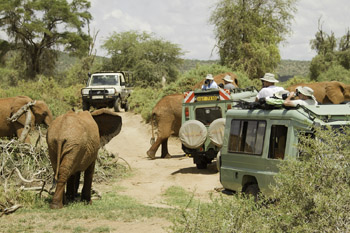 Samburu Game Reserve's semi-desert habitat hosts unique species to the country, including reticulated giraffe, distinguished by a net-like pattern; gerenuk, giraffe-like antelope that feed while standing on their hind legs; Grevy's zebra, with thin stripes and a white belly; Beisa oryx, huge antelopes with long, straight horns that may have originated the unicorn legend; and a variety of birds. Samburu affords the best chances at filming pale-chanting goshawks, hornbills, vulturine guineafowl, yellow-throated spurfowl, and dozens of other species. Samburu is also an excellent location for leopard: we don't always get them there (5 of 6 safaris we lead usually do) but the leopards we get are usually excellent for filming.
Samburu Game Reserve's semi-desert habitat hosts unique species to the country, including reticulated giraffe, distinguished by a net-like pattern; gerenuk, giraffe-like antelope that feed while standing on their hind legs; Grevy's zebra, with thin stripes and a white belly; Beisa oryx, huge antelopes with long, straight horns that may have originated the unicorn legend; and a variety of birds. Samburu affords the best chances at filming pale-chanting goshawks, hornbills, vulturine guineafowl, yellow-throated spurfowl, and dozens of other species. Samburu is also an excellent location for leopard: we don't always get them there (5 of 6 safaris we lead usually do) but the leopards we get are usually excellent for filming.
 Lake Nakuru has, in the past, supported one of the largest populations of lesser flamingos in the world, and in good years there are, quite literally, millions of birds along the shorelines. For the last few years the water levels of the lake have risen and the flamingos have declined in number.
Lake Nakuru has, in the past, supported one of the largest populations of lesser flamingos in the world, and in good years there are, quite literally, millions of birds along the shorelines. For the last few years the water levels of the lake have risen and the flamingos have declined in number.
Our target species here are White Rhinos and Rothschild Giraffes.
Nakuru offers other great subjects that you are quite likely to film very well, including African buffalo, DeFassa waterbuck, impala, warthog, reedbuck,
Rothschild giraffe, and olive baboon.
 The Masai Mara is considered part of the famous Serengeti ecosystem, but
The Masai Mara is considered part of the famous Serengeti ecosystem, but
differs in offering a variety of habitats. Within a morning's game drive one can film short grass high country, tall grass prairie, riverine forests and
thickets, and acacia thorn scrubland. Elephants, hippos, Masai giraffe,
common zebra, gnu, impala, Thompson's and Grant's gazelles, topi,
hartebeest, hyrax, black-backed jackal, spotted hyena, cheetah, leopard,
and lion are permanent residents within the park.
There's also several less common species of antelope, including reedbuck, bushbuck, steinbuck, oribi, and duiker, that we normally encounter.
The very endangered black rhino has made its last stand in the Mara here.
Additionally, serval (a small spotted cat) are most
easily found here, and in the scattered acacia trees leopards hang their
carcasses out of reach of the many lions. Consequently, it's easiest to find tree-climbing leopards here. The Mara, however, is diverse, and it is impossible to do the Park justice by basing out of only one lodge. To cover the park thoroughly we'll be based out of three different lodges. In the Mara Triangle we'll stay at Mara Serena; and in the northern section we'll be covering the Mara North Conservancy; and in the middle section of the Mara we'll be covering the area around Mara Intredpids.
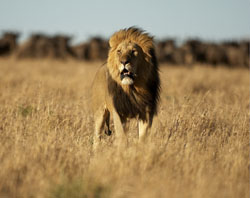


Who Is This Safari For?
This safari is really for anyone who is serious, either about wildlife and nature photography, or about in-depth, intense, and patient animal viewing. The two, for a photographer, are the same, for patience, time, and luck are required in order to obtain great wildlife images. While almost everyone who travels with us are like-minded, there are, on occasion, one or two people who are not. This is not a safari for tourists. This is a safari for photographers - serious amateurs or photo enthusiasts or pros, and for those who really want to do a safari right.
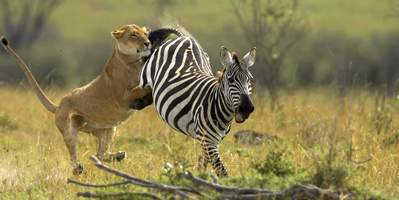 Patience may not be a five-minute wait. It may mean waiting an hour before a cheetah and her cubs decide to move from a croton thicket, or before a den
Patience may not be a five-minute wait. It may mean waiting an hour before a cheetah and her cubs decide to move from a croton thicket, or before a den
full of hyena cubs wake up and begin to play. We have literally waited for four or five hours for a wildebeest river crossing. Photographers, avid naturalists, artists, and others who are serious about wildlife have no problem with this. You might.Great shots often require patience. If you simply want to see animals, click off a few pictures, and move on to another subject, then our safari is not for you. You might worry that 'spending time' waiting is wasteful, and that your time would be better spent roaming and looking for new subjects. Let me assure you that in the course of a two-week trip you will indeed see everything, but some subjects, that require waiting will reward you with extraordinary images for your patience. In other words, you'll see everything the normal tourist sees (or the impatient photographer), but you'll also see, with quality, other subjects, events, or activities that most simply do not see because they do not have the patience to wait. We do.
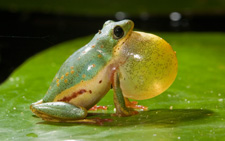 As I've already stated, photographers will get the most out of this trip, rather than the average tourist.Still photography is all about 'the individual shot' as opposed to video where screen continuity is most important.Our driver/guides and our photographers know that we will move to get the shots. Some video photographers may be frustrated by this, but the goals of a serious video photographer and a serious still photographer may be at odds, and this is a photography trip.
As I've already stated, photographers will get the most out of this trip, rather than the average tourist.Still photography is all about 'the individual shot' as opposed to video where screen continuity is most important.Our driver/guides and our photographers know that we will move to get the shots. Some video photographers may be frustrated by this, but the goals of a serious video photographer and a serious still photographer may be at odds, and this is a photography trip.
Our Unique and Fair Rotation System
We do not assign people to one vehicle for the entire trip. Instead, we rotate everyone through our vehicles
so that everyone has a chance to shoot with each other (avoiding trip-damaging cliques) and to shoot with both
Mary and me.Our rotation system gives everyone equal time with Mary and with me, and as we 'captain' our
respective vans you can be assured that we'll do our best to put you in the best shooting situation as we read
the light, determine animal behavior, or just simply look after you for the shots you're seeking
but have not yet achieved.
Mary and I are here to work for you. I joke that when you're with me you'll get the best photos,
and Mary says the same thing. We are also the only safari operators who rotate our participants in a fair basis throughout all the vehicles so that you see and work with all the driver/guides, the other participants, and with Mary and I. Our rotation -- done for both morning and afternoon game drives -- insures that you see Mary and I an equal number of times, an equal number of times with the various driver/guides, and as diverse a rotation as can be accomplished in being
with the other participants on the trip. In this way our groups become tightly knit into one big happy family.
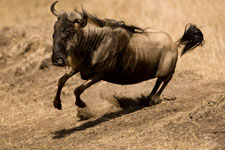
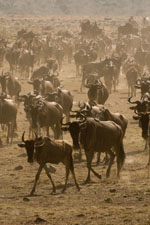
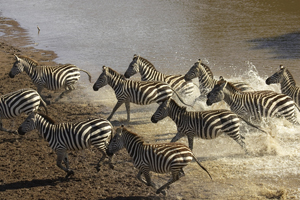
Our personal safaris with three per nine passenger vehicle are radically different from the typical 15-20 person
safari crammed with five to nine passengers to a van or a tour 'limited' to twenty or more people. For that reason
this safari is naturally more expensive, but in reality it's not that much more. Please, just ask yourself what
your objective is:
Is it to see Kenya and to take snapshots, or to be on a special photo safari designed to provide the best
shooting opportunities possible. If your answer is the latter, then this safari is for you.
What You Can Expect from Us
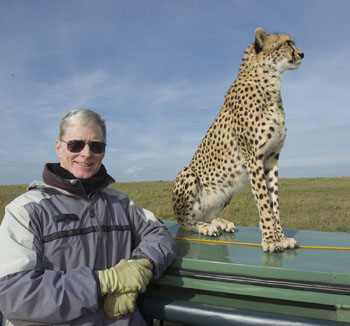 From Kenya you can expect the best, most exciting wildlife photography possible on this planet. We will prepare you photographically.
From Kenya you can expect the best, most exciting wildlife photography possible on this planet. We will prepare you photographically.
I've written a shooting guide to Kenya that you can use as a handbook
or reference when considering composition and exposure for most of
your shooting subjects. Prior to the trip we'll provide you with our own recommendations on the gear to bring and, on safari, we'll provide
thorough briefings on the subjects we expect to film and how to do so.
In the field you'll be with either Mary or myself on an average of two
out of every three game drives. That means you'll be under the guidance
of two experts here, as opposed to a tour with only one leader,
who may be a photographer and not a naturalist as well.
As I mentioned earlier, we'll do our best to get you the best shots possible, and we'll be able to provide you with our suggestions on composition and exposure and, perhaps most importantly, on what we expect to happen and where we should be. Knowing animal behavior is a real plus, if not a key to successful wildlife shooting, and our experience, and that of our fantastic Kenyandriver/guides, will insure we have the best chance at obtaining great images.
Why we have such great success...

We'll have a wide variety of animals and birds available at our three destinations. With radios in each of the
vehicles our groups can game drive independently, but can meet whenever a great subject is spotted. Unlike
many other tours our vehicles often game drive separately, fanning out to cover the largest area possible.
In this way, when one of our vehicles spots a leopard, or cheetah, or baby elephant, or similarly great subject,
everyone has the opportunity to photograph that subject, too.
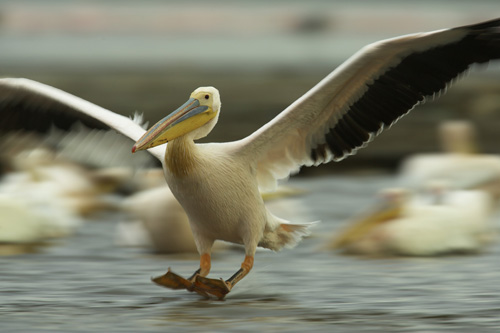
Our Itinerary
As this itinerary is planned nearly a year in advance, there's always the possibility of slight changes -- in day rooms,
flight times, etc. However, the actual field time is almost never affected by last-minute airline or hotel changes.
Day 1, Arrive in Nairobi in the late evening or early hours of Day 2.
Overnight: Nairobi
Day 2, We'll depart around 9:30AM for our drive to Samburu Game Reserve, arriving in time for a very short
(non-photographic) game drive as we drive to our lodge.
Overnight: Elephant Bedroom Camp.
Elephant Bedroom Camp is a beautiful introduction to our safari experience, with only 12 luxury tents situated
in the heart of elephant country. The staff and the food and the accommodations are incredible, and we couldn't
imagine a better place to start our photo safari.
Day 3-5, Samburu Game Reserve. Over the next three days we'll concentrate upon the wildlife, birds, and
scenery that characterize one of Kenya's prettiest parks. Along the river we'll seek elephants coming to drink
and play, crocodiles lying in wait for prey, and monkeys using the riverine forest for shelter. Samburu may offer
us leopard (it usually does), our best close-up opportunities for bird photography, and unusual endemic
mammals, including oryx, gerenuk, dik-dik, reticulated giraffe, and Grevy's zebra. By the end of our third day
we should have everything captured on film, ready to press on to our next destination.
Overnights, Elephant Bedroom Camp.
Day 6, Samburu to Lake Nakuru. We'll leave Samburu, early, for our next destination, Lake Nakuru. We'll arrive
in time for a late lunch. After lunch we will do a late afternoon game drive where we may film African white
pelicans, flamingos, and White Rhinos, the only location where we will have this species.
Overnight, Lion Hill Lodge.
Day 7, Lake Nakuru to the Mara Triangle. We'll leave and drive to the Mara Triangle. We'll stay at Mara Serena,
probably the most beautiful lodge in all of Kenya. The gardens have great songbirds and an exceptionally
tame population of bush hyrax. But we're not there for the lodge's beauty! During the fall migration,
Mara Serena is located almost directly above one of the premier river-crossing areas for wildebeest and zebras.
The area can be extremely productive for lion, cheetah, serval, and black rhino, as well as giant Nile crocodiles,
hippos, and elephants.
Overnights, Mara Serena Lodge.
Day 8-9, Mara Triangle. We'll continue to game drive around the Serena area, working on lions, cheetahs,
servals, and everything else. From Serena, we'll have the only opportunity available to game drive through the southwestern corner, often called the Mara Triangle, where, someday, I'm sure African hunting dogs will return.
Overnight, Mara Serena.
Day 10-11, Mara North Conservancy
We'll game drive from Mara Serena to the Conservancy where we'll spend that day and all of the next.The conservancy area will give us a great opportunity for some exclusive game viewing and off-track driving as we look for Lions, Leopards, and the usual plains game. There may be an opportunity for a night game drive where we would search for Aardvark.
Overnight, Elephant Pepper Luxury Safari Camp
Day 12, Mara Conservancy to Middle Mara. We'll do a final morning game drive and continue to our last destination, the upper middle section of the Mara where we'll be based at Mara Intrepids Camp. After a late lunch and a short break, we'll do our first afternoon game drive in an area that has become our favorite part of the park.
If Mary and I had only place to visit in Kenya it would be to the Upper Mara and the Mara Intrepids Camp.
It is our favorite lodge and our favorite location.
Overnight, Mara Intrepids Camp.
Day 13-14, Upper Mara. Although all of the Mara is rich, and the Mara Intrepids area is truly exceptional.
Leopards are particularly common here. Intrepids is situated along the Talek River, and many of our
game drives follow the serpentine route of the often-dry river. Intrepids' wonderful
assortment of spectacular game is a fitting ending to our safari - offering the potential of some truly
exciting photography.
Overnights, Intrepids.
Day 15, Upper Mara to Nairobi to home. We'll have a cooked breakfast before boarding our Air Kenya flight
to return to Nairobi. On your flight you'll be passing over some of the country we game drove across,
providing a new perspective to your trip. You'll have the afternoon free to pack and rest, before enjoying
your final, farewell dinner. The tour formally ends at the conclusion of this evening meal, with most
participants taking that evening's flight home (most international departures are at night), with arrival in
the US sometime on the following day after a change of planes in Europe.
Day room, the Nairobi Serena Hotel.
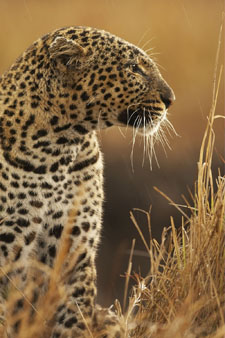
What's Included
The photo safari prices for our trips is based on land costs from Nairobi and includes all accommodations
(double occupancy), all meals except lunch in Nairobi, park entrance fees, and ground transportation,
including our exclusive three photographers per vehicles. A single rooming supplement is available.
See prices above.
Surcharge for less than 10 Participants
Our safari price is based upon 10 photography participants, filling the vehicles with three photographers per vehicle.
While there is a surcharge if the trip doesn't fill, there is a tremendous advantage for YOU, the participant, as
there will only be two photographers in these vehicles. You'll still have the benefits of our expertise when you
rotate into our vehicle, but on game drives that you're not with Mary or me you have a good chance of having
almost a private vehicle!
Our price also includes the driver/guide's tip and I know that we provide our guides with one of the very best
tips they receive each year. Our driver/guides are the best, experts at animal behavior and, from working
with me for years, quite adept at putting us into the best spots for great pictures. I use the same guides
each year and they know how I work and what's expected of them.
My Objective
You should return with the best photographs of wildlife you've ever taken. This doesn't come easily; it requires
early starts, patience, and a degree of luck. I believe any photographer traveling to Kenya wants this, and that
they're more interested in filming game than they are in lounging at a pool or in having a leisurely cooked breakfast
during the best shooting time of the day!
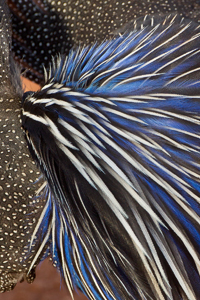 Our field days start before dawn so that we can greet the sunrise with our lenses.
Our field days start before dawn so that we can greet the sunrise with our lenses.
We'll have modest boxed picnic breakfasts on most field days.
We will stay with a subject as long as it's necessary to get great photos, provided
the goal is realistic. Don't be afraid that by doing this
you'll miss other shots. I've done enough of these (this will be my 34th year of
doing Kenya safaris) that I know what's good, what's worth our time, and where
our priorities should lie and also provide full coverage of everything you wanted to film.
You will amass a wonderful portfolio of all your Kenyan wildlife, but you won't be producing traditional boring tourist shots. We'll try to get you great images -- magic material! Although we won't be consciously amassing a species list, you'll undoubtedly see as many, if not even more, species of wildlife by doing it this way than you would by being a 'tourist,' since we'll be in the field longer, looking, watching, and photographing.
Our Roles as Leaders and Your Role
 Mary and I know Kenya, its wildlife, and how to photograph it. I want everyone
Mary and I know Kenya, its wildlife, and how to photograph it. I want everyone
to obtain great photographs, and to enjoy himself or herself while doing so. Great photography requires patience, luck, and time, plus a degree of skill that my drivers/guides and Mary and I can provide. You can trust us that everything we
do as your trip leaders will have those priorities - your photos and well-being
as an individual in our group -- in mind.
While your photography and enjoyment is always uppermost in our minds
and in our concerns for you, the welfare of our wildlife subjects still
comes first. There are no exceptions to this. We do not purposely flush
a bird to get a flight shot and we won't tolerate a guide or a participant
doing so. If we feel an animal is stressed, we leave.
About Your Leaders
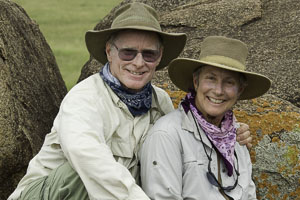 My wife Mary Ann and I strive to provide the most comfortable and
My wife Mary Ann and I strive to provide the most comfortable and
thorough safari you will experience. Both Mary and I are professional photographers, and I'd hope you've seen our credits. These included
National Geographic, National Wildlife, Ranger Rick, Natural History,
Living Bird, Birder's World, and most nature/wildlife calendars.
As a husband/wife team, Mary Ann and I have won more times in the
prestigious BBC Wildlife Photographer of the Year competition than any
one. To date we have had 15 firsts, seconds, or thirds -- and we have
not entered every year. Our trips are not about us, however, they are all
for you, but credentials seem to matter, and we have them.
Mary has written twenty-nine (29) children's books, including Leopards, Grizzly Bears, Woodpeckers,
Flying Squirrels, Sunflowers, Cobras, Jupiter, Boas, Garter Snakes, Pythons, Rattlesnakes, Ducks, Chickens, Horses, and Cows, and a coffee table book, Out of the Past, Amish Tradition and Faith.
I've written several how-to wildlife photography books -- A Practical Guide to Photographing American Wildlife,
The Wildlife Photographer's Field Manual, The Complete Guide to Wildlife Photography, Designing Wildlife
Photographs, Photographing on Safari, A Field Guide to Photographing in East Africa, and the New Complete
Guide to Wildlife Photography, African Wildlife, Creatures of the Night, The World's Deadliest, and several
ebooks. We have produced an instructional video, A Video Guide to Photographing on Safari with
Joe and Mary Ann McDonald.
We are both editors for Nature Photographer magazine.
In addition to leading our trips to Tanzania, Mary and I personally lead photo safaris to Kenya,
Brazil's Pantanal, Chile, Galapagos, Svalbard, India, Alaska, Rwanda, Yellowstone, Ecuador, Costa Rica,
the Falklands, Antarctica, South Texas, Arizona, and some other spots, too!
For some real insight into all aspects of a photo safari,
order our DVD Photographing on Safari
which covers and illustrates various camps,
how to shoot from the vehicles, what to pack,
and most importantly, what you'll photograph
and how you'll do so.
The video does not address digital workflow or digital
shooting.
Scroll through a Kenya Portfolio
Contact us by e-mail. at: info@hoothollow.com
Or Call (717) 543-6423 or FAX us at: (717) 543-6423
KENYA!
Photo Safaris
Dates: TBA
2018 was our 34th Year doing Kenya Safaris
An East African Photo Safari is the experience of a lifetime, but one that often becomes a nearly annual experience for many. We’ve been doing photo safaris for thirty years, and we not only know
what we’re doing photographically to deliver the best possible images you can make, but we also offer something few others can. We also provide the story, the natural history, the reasons why something happened, or why it may happen as we wait. We are photographers, of course, but we are also naturalists, biologists by training, and we take enormous pleasure in interpreting and making sense
of the behaviors you will see.
You can go on a safari with a photo leader and take pictures, but there is no other photo safari that will provide you with the information that explains what you are seeing, that gives meaning to
your photographs and to your experience. As our participants say, it is what truly
sets us apart from all the rest.
The complete brochure has ALL the details. But here's a quick summation.
Why we are unique
Experience.
30 years leading safaris.
We know the wildlife and how best to utilize your time.
Our rotation system insures you will have the best experience possible.
You are getting two very experienced leaders for the price most tours have for only one leader, experienced or not.
Why we offer trips in the Fall
The short rainy season has fewer people.
The skies are the most varied, offering the best light for AM and PM shooting.
Predatory babies are usually present at this time.
The unpredictable gnu migration is still likely to be present.
Featuring the Best Photographic Locations
We visit five different shooting locations.
Samburu has several unique endemics found nowhere else (easily) in Kenya.
One night in Lake Nakuru since water levels have risen
and flamingos are no longer the main attraction.
We target the most interesting species in Nakuru.
We are the only operators to visit three different locations in the Masai Mara.
Transit days in the Mara are game drives- no lost shooting opportunities.
Who is this safari for
Serious photographers and naturalists.
Folks willing to spend time waiting if it is required.
Patient photographers and naturalists.
This safari is not for 'see it and go' tourists!
Our Unique Rotation System
We rotate participants through vehicles, guides, and us.
We avoid cliques.
Participants get maximum time with us as your guides.
What you can expect from us
The most productive safari possible.
Accurate, informative natural history information.
Professional help in your photography - compositions, positioning, exposure.
Our Photo Safari Highlights
Three Photographers per vehicle maximum
Photo Instruction and Guidance in the Field
Fair and Equal Rotation of Photographers
Quality Time at the Two Best Game Areas - Samburu and the Masai Mara
Quality Time and Patience - You will see all the species but
you will see and photograph behavior too.
Three Locations in the Masai Mara - The ONLY safaris covering the entire area
The Short Rainy Season - Great skies, fewer tourists, sunny mornings, soft light in the PM
Participant Photo Show - Portfolio of our participants' work on our last evening
Photo CD - The Portfolio and more on a CD after the trip
Our Interpretation and Expertise - You can rely on our knowledge and experience to help predict
behaviors and photo opportunities
Informal Lunch and Dinner Discussions on What You Saw and what it means
Driver-Guide Tip in included in the tour price
If this interests you, please read on!
No American Photographers have more field experience
leading photo safaris to East Africa.


PRICES:
Dates: TBA Price: $TBA
(single supplement $ TBA)
To get the absolute most out of these safaris, consider taking one of our
Complete Digital Nature Photo Courses next summer!
PLEASE NOTE - Prices listed are based upon 10 participants.
There will be a small surcharge if the safari has fewer participants.
See below (What's Included) for the rationale and advantages.


For even more information, please read any of our TRIP REPORTS which detail, day-by-day, the safaris
from that year. This will give you an excellent idea of what our trips are all about, what we see,
and perhaps most importantly, how successful these trips are!
You can read all of our Kenya Trip Reports for even more information.
Click here if you'd like to
order our Photographing on Safari video,
or
to read general photo safaris information.
Contents



We know Africa, we know how to make a safari run smoothly, and we know the wildlife.
If you are interested in obtaining quality photographs, in seeing wildlife in-depth, in watching
behavior, and witnessing truly once-in-a-lifetime wildlife opportunities, then our safaris are for you.



Why do we offer trips in the Fall?
 October through early December is one of the slower seasons for tourism in Kenya,
October through early December is one of the slower seasons for tourism in Kenya,
except for our safaris and other canny photographers who follow our lead.
It is still a most spectacular time of year to visit Kenya, for during this time
the wildebeest migration may be 'in', and the short rainy season usually develops
sometime during this period, giving us great cloudscapes and skies for some
of our shooting. If the migration arrives, the bountiful supply of food often
stimulates the predators into initiating a mating. Not being far-sighted, lions
revel in the abundance of food present at the time, even though the herd may be
gone by the time any young are born. Typically, the months following the
migration is the time of lion babies, even though this season can be one of
extreme stress, as the huge herds of easy game are gone.
 Our autumn trips usually coincide with the short rainy season - either in the middle of it, or catching either the front or back end. Why travel to Kenya if it's raining? Well, for one, the rains are short - typically they occur in the late afternoon, and they are scattered. It's entirely possible to do a game drive and have rain clouds visible at all four compass points, and yet be rainless. Rains are usually short, too, and rarely compromise a game drive.However, rains generate action! The skies in the afternoon are often magnificent, as thunderheads build up into dramatic skyscapes. Landscape images are far more interesting with a great sky. Rain induces bird nesting activity, and weavers, social weavers, and hornbills actively
Our autumn trips usually coincide with the short rainy season - either in the middle of it, or catching either the front or back end. Why travel to Kenya if it's raining? Well, for one, the rains are short - typically they occur in the late afternoon, and they are scattered. It's entirely possible to do a game drive and have rain clouds visible at all four compass points, and yet be rainless. Rains are usually short, too, and rarely compromise a game drive.However, rains generate action! The skies in the afternoon are often magnificent, as thunderheads build up into dramatic skyscapes. Landscape images are far more interesting with a great sky. Rain induces bird nesting activity, and weavers, social weavers, and hornbills actively
nest when mud or new grasses are available.
Typically, mornings begin cloud free and brilliant, with clouds building during the day. This provides photographers
with the opportunity to shoot subjects in two lighting conditions - in bright light in the AM, and, perhaps, overcast conditions in the afternoon. As one would expect, along the equator the heat builds up through the day and, on a cloudless day, it can get rather warm by late afternoon. Clouds cool things off, so nocturnal animals, like leopards,
are much more likely to be active on a cool day than on a hot, sunny afternoon. Another perk for this season!
 We'll be visiting five locations on this safari. Samburu, in the arid, semi-desert area of north central Kenya, Lake Nakuru, mid-way on our journey from one
We'll be visiting five locations on this safari. Samburu, in the arid, semi-desert area of north central Kenya, Lake Nakuru, mid-way on our journey from one
reserve to the other, and three locations in the Masai Mara.
Samburu at this time of year should be filled with bird life. The short rains
should have some influence on the landscape and with luck the vegetation
will be morphing from dry season brown to verdant short-rain green.
Bird activity can be one of your trip highlights here! Of course, the usual
wildlife - elephants, the herd animals and ungulates, and the predators will
be in their normal numbers, but the bird life can be outstanding.
It is too long a drive to travel from Samburu to the Mara in a single day.
We'll be overnighting at Lake Nakuru, arriving in time for a late lunch. After
lunch we'll do an afternoon game drive, and another all-morning game drive
where we'll concentrate on the incredible flamingos.
To sum up, our focus of this trip will include the following:



Bird life in Samburu - One of the most surprising aspects to many safari photographers is the variety
of bird life available. Samburu is the premiere bird location, with a large variety of birds of prey, as well as diverse other birds, and many of the tracks run through vegetation that is no higher than our vehicles' roofs, so eye-level shooting is easy.




Mammals in Samburu -
Several endemic mammals are found nowhere else (see our itenerary), including the upright-standing gerenuk,
the tiny dik-dik, the unicorn-like oryx, and the reticulated giraffe.
We'll have one of our best chances of photographing a leopard here.



Wildlife in Nakuru - although we'll only be spending a short period of time here,
we'll have ample opportunity for photographing the species we normally encounter here, including White Rhinos, Black Rhinos,and Rothschild Giraffes, .

Predatory Action in the Mara - Lions and Cheetahs are likely to be hunting, and if there is any
possibility of photographing incredible action, we will do it.



Baby Predators in the Mara - We usually get lion cubs and cheetah cubs.
One of the true advantages to our safaris, and this is truly unique, is our staying
at three different, widely spaced lodges in the Masai Mara. By doing so,
we can cover virtually the entire area, which is simply not possible if you are based at
only one location.



The Usual Stars - of course, we'll also be photographing all the mammals we normally encounter.



Featuring the Best Photographic Locations in Kenya
 Samburu Game Reserve's semi-desert habitat hosts unique species to the country, including reticulated giraffe, distinguished by a net-like pattern; gerenuk, giraffe-like antelope that feed while standing on their hind legs; Grevy's zebra, with thin stripes and a white belly; Beisa oryx, huge antelopes with long, straight horns that may have originated the unicorn legend; and a variety of birds. Samburu affords the best chances at filming pale-chanting goshawks, hornbills, vulturine guineafowl, yellow-throated spurfowl, and dozens of other species. Samburu is also an excellent location for leopard: we don't always get them there (5 of 6 safaris we lead usually do) but the leopards we get are usually excellent for filming.
Samburu Game Reserve's semi-desert habitat hosts unique species to the country, including reticulated giraffe, distinguished by a net-like pattern; gerenuk, giraffe-like antelope that feed while standing on their hind legs; Grevy's zebra, with thin stripes and a white belly; Beisa oryx, huge antelopes with long, straight horns that may have originated the unicorn legend; and a variety of birds. Samburu affords the best chances at filming pale-chanting goshawks, hornbills, vulturine guineafowl, yellow-throated spurfowl, and dozens of other species. Samburu is also an excellent location for leopard: we don't always get them there (5 of 6 safaris we lead usually do) but the leopards we get are usually excellent for filming.
 Lake Nakuru has, in the past, supported one of the largest populations of lesser flamingos in the world, and in good years there are, quite literally, millions of birds along the shorelines. For the last few years the water levels of the lake have risen and the flamingos have declined in number.
Lake Nakuru has, in the past, supported one of the largest populations of lesser flamingos in the world, and in good years there are, quite literally, millions of birds along the shorelines. For the last few years the water levels of the lake have risen and the flamingos have declined in number.
Our target species here are White Rhinos and Rothschild Giraffes.
Nakuru offers other great subjects that you are quite likely to film very well, including African buffalo, DeFassa waterbuck, impala, warthog, reedbuck,
Rothschild giraffe, and olive baboon.
 The Masai Mara is considered part of the famous Serengeti ecosystem, but
The Masai Mara is considered part of the famous Serengeti ecosystem, but
differs in offering a variety of habitats. Within a morning's game drive one can film short grass high country, tall grass prairie, riverine forests and
thickets, and acacia thorn scrubland. Elephants, hippos, Masai giraffe,
common zebra, gnu, impala, Thompson's and Grant's gazelles, topi,
hartebeest, hyrax, black-backed jackal, spotted hyena, cheetah, leopard,
and lion are permanent residents within the park.
There's also several less common species of antelope, including reedbuck, bushbuck, steinbuck, oribi, and duiker, that we normally encounter.
The very endangered black rhino has made its last stand in the Mara here.
Additionally, serval (a small spotted cat) are most
easily found here, and in the scattered acacia trees leopards hang their
carcasses out of reach of the many lions. Consequently, it's easiest to find tree-climbing leopards here. The Mara, however, is diverse, and it is impossible to do the Park justice by basing out of only one lodge. To cover the park thoroughly we'll be based out of three different lodges. In the Mara Triangle we'll stay at Mara Serena; and in the northern section we'll be covering the Mara North Conservancy; and in the middle section of the Mara we'll be covering the area around Mara Intredpids.



Who Is This Safari For?
This safari is really for anyone who is serious, either about wildlife and nature photography, or about in-depth, intense, and patient animal viewing. The two, for a photographer, are the same, for patience, time, and luck are required in order to obtain great wildlife images. While almost everyone who travels with us are like-minded, there are, on occasion, one or two people who are not. This is not a safari for tourists. This is a safari for photographers - serious amateurs or photo enthusiasts or pros, and for those who really want to do a safari right.
 Patience may not be a five-minute wait. It may mean waiting an hour before a cheetah and her cubs decide to move from a croton thicket, or before a den
Patience may not be a five-minute wait. It may mean waiting an hour before a cheetah and her cubs decide to move from a croton thicket, or before a den
full of hyena cubs wake up and begin to play. We have literally waited for four or five hours for a wildebeest river crossing. Photographers, avid naturalists, artists, and others who are serious about wildlife have no problem with this. You might.Great shots often require patience. If you simply want to see animals, click off a few pictures, and move on to another subject, then our safari is not for you. You might worry that 'spending time' waiting is wasteful, and that your time would be better spent roaming and looking for new subjects. Let me assure you that in the course of a two-week trip you will indeed see everything, but some subjects, that require waiting will reward you with extraordinary images for your patience. In other words, you'll see everything the normal tourist sees (or the impatient photographer), but you'll also see, with quality, other subjects, events, or activities that most simply do not see because they do not have the patience to wait. We do.
 As I've already stated, photographers will get the most out of this trip, rather than the average tourist.Still photography is all about 'the individual shot' as opposed to video where screen continuity is most important.Our driver/guides and our photographers know that we will move to get the shots. Some video photographers may be frustrated by this, but the goals of a serious video photographer and a serious still photographer may be at odds, and this is a photography trip.
As I've already stated, photographers will get the most out of this trip, rather than the average tourist.Still photography is all about 'the individual shot' as opposed to video where screen continuity is most important.Our driver/guides and our photographers know that we will move to get the shots. Some video photographers may be frustrated by this, but the goals of a serious video photographer and a serious still photographer may be at odds, and this is a photography trip.
Our Unique and Fair Rotation System
We do not assign people to one vehicle for the entire trip. Instead, we rotate everyone through our vehicles
so that everyone has a chance to shoot with each other (avoiding trip-damaging cliques) and to shoot with both
Mary and me.Our rotation system gives everyone equal time with Mary and with me, and as we 'captain' our
respective vans you can be assured that we'll do our best to put you in the best shooting situation as we read
the light, determine animal behavior, or just simply look after you for the shots you're seeking
but have not yet achieved.
Mary and I are here to work for you. I joke that when you're with me you'll get the best photos,
and Mary says the same thing. We are also the only safari operators who rotate our participants in a fair basis throughout all the vehicles so that you see and work with all the driver/guides, the other participants, and with Mary and I. Our rotation -- done for both morning and afternoon game drives -- insures that you see Mary and I an equal number of times, an equal number of times with the various driver/guides, and as diverse a rotation as can be accomplished in being
with the other participants on the trip. In this way our groups become tightly knit into one big happy family.



Our personal safaris with three per nine passenger vehicle are radically different from the typical 15-20 person
safari crammed with five to nine passengers to a van or a tour 'limited' to twenty or more people. For that reason
this safari is naturally more expensive, but in reality it's not that much more. Please, just ask yourself what
your objective is:
Is it to see Kenya and to take snapshots, or to be on a special photo safari designed to provide the best
shooting opportunities possible. If your answer is the latter, then this safari is for you.
What You Can Expect from Us
 From Kenya you can expect the best, most exciting wildlife photography possible on this planet. We will prepare you photographically.
From Kenya you can expect the best, most exciting wildlife photography possible on this planet. We will prepare you photographically.
I've written a shooting guide to Kenya that you can use as a handbook
or reference when considering composition and exposure for most of
your shooting subjects. Prior to the trip we'll provide you with our own recommendations on the gear to bring and, on safari, we'll provide
thorough briefings on the subjects we expect to film and how to do so.
In the field you'll be with either Mary or myself on an average of two
out of every three game drives. That means you'll be under the guidance
of two experts here, as opposed to a tour with only one leader,
who may be a photographer and not a naturalist as well.
As I mentioned earlier, we'll do our best to get you the best shots possible, and we'll be able to provide you with our suggestions on composition and exposure and, perhaps most importantly, on what we expect to happen and where we should be. Knowing animal behavior is a real plus, if not a key to successful wildlife shooting, and our experience, and that of our fantastic Kenyandriver/guides, will insure we have the best chance at obtaining great images.
Why we have such great success...

We'll have a wide variety of animals and birds available at our three destinations. With radios in each of the
vehicles our groups can game drive independently, but can meet whenever a great subject is spotted. Unlike
many other tours our vehicles often game drive separately, fanning out to cover the largest area possible.
In this way, when one of our vehicles spots a leopard, or cheetah, or baby elephant, or similarly great subject,
everyone has the opportunity to photograph that subject, too.

Our Itinerary
As this itinerary is planned nearly a year in advance, there's always the possibility of slight changes -- in day rooms,
flight times, etc. However, the actual field time is almost never affected by last-minute airline or hotel changes.
Day 1, Arrive in Nairobi in the late evening or early hours of Day 2.
Overnight: Nairobi
Day 2, We'll depart around 9:30AM for our drive to Samburu Game Reserve, arriving in time for a very short
(non-photographic) game drive as we drive to our lodge.
Overnight: Elephant Bedroom Camp.
Elephant Bedroom Camp is a beautiful introduction to our safari experience, with only 12 luxury tents situated
in the heart of elephant country. The staff and the food and the accommodations are incredible, and we couldn't
imagine a better place to start our photo safari.
Day 3-5, Samburu Game Reserve. Over the next three days we'll concentrate upon the wildlife, birds, and
scenery that characterize one of Kenya's prettiest parks. Along the river we'll seek elephants coming to drink
and play, crocodiles lying in wait for prey, and monkeys using the riverine forest for shelter. Samburu may offer
us leopard (it usually does), our best close-up opportunities for bird photography, and unusual endemic
mammals, including oryx, gerenuk, dik-dik, reticulated giraffe, and Grevy's zebra. By the end of our third day
we should have everything captured on film, ready to press on to our next destination.
Overnights, Elephant Bedroom Camp.
Day 6, Samburu to Lake Nakuru. We'll leave Samburu, early, for our next destination, Lake Nakuru. We'll arrive
in time for a late lunch. After lunch we will do a late afternoon game drive where we may film African white
pelicans, flamingos, and White Rhinos, the only location where we will have this species.
Overnight, Lion Hill Lodge.
Day 7, Lake Nakuru to the Mara Triangle. We'll leave and drive to the Mara Triangle. We'll stay at Mara Serena,
probably the most beautiful lodge in all of Kenya. The gardens have great songbirds and an exceptionally
tame population of bush hyrax. But we're not there for the lodge's beauty! During the fall migration,
Mara Serena is located almost directly above one of the premier river-crossing areas for wildebeest and zebras.
The area can be extremely productive for lion, cheetah, serval, and black rhino, as well as giant Nile crocodiles,
hippos, and elephants.
Overnights, Mara Serena Lodge.
Day 8-9, Mara Triangle. We'll continue to game drive around the Serena area, working on lions, cheetahs,
servals, and everything else. From Serena, we'll have the only opportunity available to game drive through the southwestern corner, often called the Mara Triangle, where, someday, I'm sure African hunting dogs will return.
Overnight, Mara Serena.
Day 10-11, Mara North Conservancy
We'll game drive from Mara Serena to the Conservancy where we'll spend that day and all of the next.The conservancy area will give us a great opportunity for some exclusive game viewing and off-track driving as we look for Lions, Leopards, and the usual plains game. There may be an opportunity for a night game drive where we would search for Aardvark.
Overnight, Elephant Pepper Luxury Safari Camp
Day 12, Mara Conservancy to Middle Mara. We'll do a final morning game drive and continue to our last destination, the upper middle section of the Mara where we'll be based at Mara Intrepids Camp. After a late lunch and a short break, we'll do our first afternoon game drive in an area that has become our favorite part of the park.
If Mary and I had only place to visit in Kenya it would be to the Upper Mara and the Mara Intrepids Camp.
It is our favorite lodge and our favorite location.
Overnight, Mara Intrepids Camp.
Day 13-14, Upper Mara. Although all of the Mara is rich, and the Mara Intrepids area is truly exceptional.
Leopards are particularly common here. Intrepids is situated along the Talek River, and many of our
game drives follow the serpentine route of the often-dry river. Intrepids' wonderful
assortment of spectacular game is a fitting ending to our safari - offering the potential of some truly
exciting photography.
Overnights, Intrepids.
Day 15, Upper Mara to Nairobi to home. We'll have a cooked breakfast before boarding our Air Kenya flight
to return to Nairobi. On your flight you'll be passing over some of the country we game drove across,
providing a new perspective to your trip. You'll have the afternoon free to pack and rest, before enjoying
your final, farewell dinner. The tour formally ends at the conclusion of this evening meal, with most
participants taking that evening's flight home (most international departures are at night), with arrival in
the US sometime on the following day after a change of planes in Europe.
Day room, the Nairobi Serena Hotel.

What's Included
The photo safari prices for our trips is based on land costs from Nairobi and includes all accommodations
(double occupancy), all meals except lunch in Nairobi, park entrance fees, and ground transportation,
including our exclusive three photographers per vehicles. A single rooming supplement is available.
See prices above.
Surcharge for less than 10 Participants
Our safari price is based upon 10 photography participants, filling the vehicles with three photographers per vehicle.
While there is a surcharge if the trip doesn't fill, there is a tremendous advantage for YOU, the participant, as
there will only be two photographers in these vehicles. You'll still have the benefits of our expertise when you
rotate into our vehicle, but on game drives that you're not with Mary or me you have a good chance of having
almost a private vehicle!
Our price also includes the driver/guide's tip and I know that we provide our guides with one of the very best
tips they receive each year. Our driver/guides are the best, experts at animal behavior and, from working
with me for years, quite adept at putting us into the best spots for great pictures. I use the same guides
each year and they know how I work and what's expected of them.
My Objective
You should return with the best photographs of wildlife you've ever taken. This doesn't come easily; it requires
early starts, patience, and a degree of luck. I believe any photographer traveling to Kenya wants this, and that
they're more interested in filming game than they are in lounging at a pool or in having a leisurely cooked breakfast
during the best shooting time of the day!
 Our field days start before dawn so that we can greet the sunrise with our lenses.
Our field days start before dawn so that we can greet the sunrise with our lenses.
We'll have modest boxed picnic breakfasts on most field days.
We will stay with a subject as long as it's necessary to get great photos, provided
the goal is realistic. Don't be afraid that by doing this
you'll miss other shots. I've done enough of these (this will be my 34th year of
doing Kenya safaris) that I know what's good, what's worth our time, and where
our priorities should lie and also provide full coverage of everything you wanted to film.
You will amass a wonderful portfolio of all your Kenyan wildlife, but you won't be producing traditional boring tourist shots. We'll try to get you great images -- magic material! Although we won't be consciously amassing a species list, you'll undoubtedly see as many, if not even more, species of wildlife by doing it this way than you would by being a 'tourist,' since we'll be in the field longer, looking, watching, and photographing.
Our Roles as Leaders and Your Role
 Mary and I know Kenya, its wildlife, and how to photograph it. I want everyone
Mary and I know Kenya, its wildlife, and how to photograph it. I want everyone
to obtain great photographs, and to enjoy himself or herself while doing so. Great photography requires patience, luck, and time, plus a degree of skill that my drivers/guides and Mary and I can provide. You can trust us that everything we
do as your trip leaders will have those priorities - your photos and well-being
as an individual in our group -- in mind.
While your photography and enjoyment is always uppermost in our minds
and in our concerns for you, the welfare of our wildlife subjects still
comes first. There are no exceptions to this. We do not purposely flush
a bird to get a flight shot and we won't tolerate a guide or a participant
doing so. If we feel an animal is stressed, we leave.
About Your Leaders
 My wife Mary Ann and I strive to provide the most comfortable and
My wife Mary Ann and I strive to provide the most comfortable and
thorough safari you will experience. Both Mary and I are professional photographers, and I'd hope you've seen our credits. These included
National Geographic, National Wildlife, Ranger Rick, Natural History,
Living Bird, Birder's World, and most nature/wildlife calendars.
As a husband/wife team, Mary Ann and I have won more times in the
prestigious BBC Wildlife Photographer of the Year competition than any
one. To date we have had 15 firsts, seconds, or thirds -- and we have
not entered every year. Our trips are not about us, however, they are all
for you, but credentials seem to matter, and we have them.
Mary has written twenty-nine (29) children's books, including Leopards, Grizzly Bears, Woodpeckers,
Flying Squirrels, Sunflowers, Cobras, Jupiter, Boas, Garter Snakes, Pythons, Rattlesnakes, Ducks, Chickens, Horses, and Cows, and a coffee table book, Out of the Past, Amish Tradition and Faith.
I've written several how-to wildlife photography books -- A Practical Guide to Photographing American Wildlife,
The Wildlife Photographer's Field Manual, The Complete Guide to Wildlife Photography, Designing Wildlife
Photographs, Photographing on Safari, A Field Guide to Photographing in East Africa, and the New Complete
Guide to Wildlife Photography, African Wildlife, Creatures of the Night, The World's Deadliest, and several
ebooks. We have produced an instructional video, A Video Guide to Photographing on Safari with
Joe and Mary Ann McDonald.
We are both editors for Nature Photographer magazine.
In addition to leading our trips to Tanzania, Mary and I personally lead photo safaris to Kenya,
Brazil's Pantanal, Chile, Galapagos, Svalbard, India, Alaska, Rwanda, Yellowstone, Ecuador, Costa Rica,
the Falklands, Antarctica, South Texas, Arizona, and some other spots, too!
For some real insight into all aspects of a photo safari,
order our DVD Photographing on Safari
which covers and illustrates various camps,
how to shoot from the vehicles, what to pack,
and most importantly, what you'll photograph
and how you'll do so.
The video does not address digital workflow or digital
shooting.
Scroll through a Kenya Portfolio
Contact us by e-mail. at: info@hoothollow.com
Or Call (717) 543-6423 or FAX us at: (717) 543-6423
KENYA!
Photo Safaris
Dates: TBA
2018 was our 34th Year doing Kenya Safaris
An East African Photo Safari is the experience of a lifetime, but one that often becomes a nearly annual experience for many. We’ve been doing photo safaris for thirty years, and we not only know
what we’re doing photographically to deliver the best possible images you can make, but we also offer something few others can. We also provide the story, the natural history, the reasons why something happened, or why it may happen as we wait. We are photographers, of course, but we are also naturalists, biologists by training, and we take enormous pleasure in interpreting and making sense
of the behaviors you will see.
You can go on a safari with a photo leader and take pictures, but there is no other photo safari that will provide you with the information that explains what you are seeing, that gives meaning to
your photographs and to your experience. As our participants say, it is what truly
sets us apart from all the rest.
The complete brochure has ALL the details. But here's a quick summation.
Why we are unique
Experience.
30 years leading safaris.
We know the wildlife and how best to utilize your time.
Our rotation system insures you will have the best experience possible.
You are getting two very experienced leaders for the price most tours have for only one leader, experienced or not.
Why we offer trips in the Fall
The short rainy season has fewer people.
The skies are the most varied, offering the best light for AM and PM shooting.
Predatory babies are usually present at this time.
The unpredictable gnu migration is still likely to be present.
Featuring the Best Photographic Locations
We visit five different shooting locations.
Samburu has several unique endemics found nowhere else (easily) in Kenya.
One night in Lake Nakuru since water levels have risen
and flamingos are no longer the main attraction.
We target the most interesting species in Nakuru.
We are the only operators to visit three different locations in the Masai Mara.
Transit days in the Mara are game drives- no lost shooting opportunities.
Who is this safari for
Serious photographers and naturalists.
Folks willing to spend time waiting if it is required.
Patient photographers and naturalists.
This safari is not for 'see it and go' tourists!
Our Unique Rotation System
We rotate participants through vehicles, guides, and us.
We avoid cliques.
Participants get maximum time with us as your guides.
What you can expect from us
The most productive safari possible.
Accurate, informative natural history information.
Professional help in your photography - compositions, positioning, exposure.
Our Photo Safari Highlights
Three Photographers per vehicle maximum
Photo Instruction and Guidance in the Field
Fair and Equal Rotation of Photographers
Quality Time at the Two Best Game Areas - Samburu and the Masai Mara
Quality Time and Patience - You will see all the species but
you will see and photograph behavior too.
Three Locations in the Masai Mara - The ONLY safaris covering the entire area
The Short Rainy Season - Great skies, fewer tourists, sunny mornings, soft light in the PM
Participant Photo Show - Portfolio of our participants' work on our last evening
Photo CD - The Portfolio and more on a CD after the trip
Our Interpretation and Expertise - You can rely on our knowledge and experience to help predict
behaviors and photo opportunities
Informal Lunch and Dinner Discussions on What You Saw and what it means
Driver-Guide Tip in included in the tour price
If this interests you, please read on!
No American Photographers have more field experience
leading photo safaris to East Africa.
Photo Safaris
Dates: TBA
2018 was our 34th Year doing Kenya Safaris
An East African Photo Safari is the experience of a lifetime, but one that often becomes a nearly annual experience for many. We’ve been doing photo safaris for thirty years, and we not only know
what we’re doing photographically to deliver the best possible images you can make, but we also offer something few others can. We also provide the story, the natural history, the reasons why something happened, or why it may happen as we wait. We are photographers, of course, but we are also naturalists, biologists by training, and we take enormous pleasure in interpreting and making sense
of the behaviors you will see.
You can go on a safari with a photo leader and take pictures, but there is no other photo safari that will provide you with the information that explains what you are seeing, that gives meaning to
your photographs and to your experience. As our participants say, it is what truly
sets us apart from all the rest.
The complete brochure has ALL the details. But here's a quick summation.
Why we are unique
Experience.
30 years leading safaris.
We know the wildlife and how best to utilize your time.
Our rotation system insures you will have the best experience possible.
You are getting two very experienced leaders for the price most tours have for only one leader, experienced or not.
Why we offer trips in the Fall
The short rainy season has fewer people.
The skies are the most varied, offering the best light for AM and PM shooting.
Predatory babies are usually present at this time.
The unpredictable gnu migration is still likely to be present.
Featuring the Best Photographic Locations
We visit five different shooting locations.
Samburu has several unique endemics found nowhere else (easily) in Kenya.
One night in Lake Nakuru since water levels have risen
and flamingos are no longer the main attraction.
We target the most interesting species in Nakuru.
We are the only operators to visit three different locations in the Masai Mara.
Transit days in the Mara are game drives- no lost shooting opportunities.
Who is this safari for
Serious photographers and naturalists.
Folks willing to spend time waiting if it is required.
Patient photographers and naturalists.
This safari is not for 'see it and go' tourists!
Our Unique Rotation System
We rotate participants through vehicles, guides, and us.
We avoid cliques.
Participants get maximum time with us as your guides.
What you can expect from us
The most productive safari possible.
Accurate, informative natural history information.
Professional help in your photography - compositions, positioning, exposure.
Our Photo Safari Highlights
Three Photographers per vehicle maximum
Photo Instruction and Guidance in the Field
Fair and Equal Rotation of Photographers
Quality Time at the Two Best Game Areas - Samburu and the Masai Mara
Quality Time and Patience - You will see all the species but
you will see and photograph behavior too.
Three Locations in the Masai Mara - The ONLY safaris covering the entire area
The Short Rainy Season - Great skies, fewer tourists, sunny mornings, soft light in the PM
Participant Photo Show - Portfolio of our participants' work on our last evening
Photo CD - The Portfolio and more on a CD after the trip
Our Interpretation and Expertise - You can rely on our knowledge and experience to help predict
behaviors and photo opportunities
Informal Lunch and Dinner Discussions on What You Saw and what it means
Driver-Guide Tip in included in the tour price
If this interests you, please read on!
No American Photographers have more field experience
leading photo safaris to East Africa.


PRICES:
Dates: TBA Price: $TBA
(single supplement $ TBA)


PRICES:
Dates: TBA Price: $TBA
(single supplement $ TBA)
To get the absolute most out of these safaris, consider taking one of our
Complete Digital Nature Photo Courses next summer!
PLEASE NOTE - Prices listed are based upon 10 participants.
There will be a small surcharge if the safari has fewer participants.
See below (What's Included) for the rationale and advantages.


For even more information, please read any of our TRIP REPORTS which detail, day-by-day, the safaris
from that year. This will give you an excellent idea of what our trips are all about, what we see,
and perhaps most importantly, how successful these trips are!
You can read all of our Kenya Trip Reports for even more information.
Click here if you'd like to
order our Photographing on Safari video,
or
to read general photo safaris information.



We know Africa, we know how to make a safari run smoothly, and we know the wildlife.
If you are interested in obtaining quality photographs, in seeing wildlife in-depth, in watching
behavior, and witnessing truly once-in-a-lifetime wildlife opportunities, then our safaris are for you.



Why do we offer trips in the Fall?
 October through early December is one of the slower seasons for tourism in Kenya,
October through early December is one of the slower seasons for tourism in Kenya,
except for our safaris and other canny photographers who follow our lead.
It is still a most spectacular time of year to visit Kenya, for during this time
the wildebeest migration may be 'in', and the short rainy season usually develops
sometime during this period, giving us great cloudscapes and skies for some
of our shooting. If the migration arrives, the bountiful supply of food often
stimulates the predators into initiating a mating. Not being far-sighted, lions
revel in the abundance of food present at the time, even though the herd may be
gone by the time any young are born. Typically, the months following the
migration is the time of lion babies, even though this season can be one of
extreme stress, as the huge herds of easy game are gone.
 Our autumn trips usually coincide with the short rainy season - either in the middle of it, or catching either the front or back end. Why travel to Kenya if it's raining? Well, for one, the rains are short - typically they occur in the late afternoon, and they are scattered. It's entirely possible to do a game drive and have rain clouds visible at all four compass points, and yet be rainless. Rains are usually short, too, and rarely compromise a game drive.However, rains generate action! The skies in the afternoon are often magnificent, as thunderheads build up into dramatic skyscapes. Landscape images are far more interesting with a great sky. Rain induces bird nesting activity, and weavers, social weavers, and hornbills actively
Our autumn trips usually coincide with the short rainy season - either in the middle of it, or catching either the front or back end. Why travel to Kenya if it's raining? Well, for one, the rains are short - typically they occur in the late afternoon, and they are scattered. It's entirely possible to do a game drive and have rain clouds visible at all four compass points, and yet be rainless. Rains are usually short, too, and rarely compromise a game drive.However, rains generate action! The skies in the afternoon are often magnificent, as thunderheads build up into dramatic skyscapes. Landscape images are far more interesting with a great sky. Rain induces bird nesting activity, and weavers, social weavers, and hornbills actively
nest when mud or new grasses are available.
Typically, mornings begin cloud free and brilliant, with clouds building during the day. This provides photographers
with the opportunity to shoot subjects in two lighting conditions - in bright light in the AM, and, perhaps, overcast conditions in the afternoon. As one would expect, along the equator the heat builds up through the day and, on a cloudless day, it can get rather warm by late afternoon. Clouds cool things off, so nocturnal animals, like leopards,
are much more likely to be active on a cool day than on a hot, sunny afternoon. Another perk for this season!
 We'll be visiting five locations on this safari. Samburu, in the arid, semi-desert area of north central Kenya, Lake Nakuru, mid-way on our journey from one
We'll be visiting five locations on this safari. Samburu, in the arid, semi-desert area of north central Kenya, Lake Nakuru, mid-way on our journey from one
reserve to the other, and three locations in the Masai Mara.
Samburu at this time of year should be filled with bird life. The short rains
should have some influence on the landscape and with luck the vegetation
will be morphing from dry season brown to verdant short-rain green.
Bird activity can be one of your trip highlights here! Of course, the usual
wildlife - elephants, the herd animals and ungulates, and the predators will
be in their normal numbers, but the bird life can be outstanding.
It is too long a drive to travel from Samburu to the Mara in a single day.
We'll be overnighting at Lake Nakuru, arriving in time for a late lunch. After
lunch we'll do an afternoon game drive, and another all-morning game drive
where we'll concentrate on the incredible flamingos.
To sum up, our focus of this trip will include the following:



Bird life in Samburu - One of the most surprising aspects to many safari photographers is the variety
of bird life available. Samburu is the premiere bird location, with a large variety of birds of prey, as well as diverse other birds, and many of the tracks run through vegetation that is no higher than our vehicles' roofs, so eye-level shooting is easy.




Mammals in Samburu -
Several endemic mammals are found nowhere else (see our itenerary), including the upright-standing gerenuk,
the tiny dik-dik, the unicorn-like oryx, and the reticulated giraffe.
We'll have one of our best chances of photographing a leopard here.



Wildlife in Nakuru - although we'll only be spending a short period of time here,
we'll have ample opportunity for photographing the species we normally encounter here, including White Rhinos, Black Rhinos,and Rothschild Giraffes, .

Predatory Action in the Mara - Lions and Cheetahs are likely to be hunting, and if there is any
possibility of photographing incredible action, we will do it.



Baby Predators in the Mara - We usually get lion cubs and cheetah cubs.
One of the true advantages to our safaris, and this is truly unique, is our staying
at three different, widely spaced lodges in the Masai Mara. By doing so,
we can cover virtually the entire area, which is simply not possible if you are based at
only one location.



The Usual Stars - of course, we'll also be photographing all the mammals we normally encounter.



 Samburu Game Reserve's semi-desert habitat hosts unique species to the country, including reticulated giraffe, distinguished by a net-like pattern; gerenuk, giraffe-like antelope that feed while standing on their hind legs; Grevy's zebra, with thin stripes and a white belly; Beisa oryx, huge antelopes with long, straight horns that may have originated the unicorn legend; and a variety of birds. Samburu affords the best chances at filming pale-chanting goshawks, hornbills, vulturine guineafowl, yellow-throated spurfowl, and dozens of other species. Samburu is also an excellent location for leopard: we don't always get them there (5 of 6 safaris we lead usually do) but the leopards we get are usually excellent for filming.
Samburu Game Reserve's semi-desert habitat hosts unique species to the country, including reticulated giraffe, distinguished by a net-like pattern; gerenuk, giraffe-like antelope that feed while standing on their hind legs; Grevy's zebra, with thin stripes and a white belly; Beisa oryx, huge antelopes with long, straight horns that may have originated the unicorn legend; and a variety of birds. Samburu affords the best chances at filming pale-chanting goshawks, hornbills, vulturine guineafowl, yellow-throated spurfowl, and dozens of other species. Samburu is also an excellent location for leopard: we don't always get them there (5 of 6 safaris we lead usually do) but the leopards we get are usually excellent for filming.
 Lake Nakuru has, in the past, supported one of the largest populations of lesser flamingos in the world, and in good years there are, quite literally, millions of birds along the shorelines. For the last few years the water levels of the lake have risen and the flamingos have declined in number.
Lake Nakuru has, in the past, supported one of the largest populations of lesser flamingos in the world, and in good years there are, quite literally, millions of birds along the shorelines. For the last few years the water levels of the lake have risen and the flamingos have declined in number.
Our target species here are White Rhinos and Rothschild Giraffes.
Nakuru offers other great subjects that you are quite likely to film very well, including African buffalo, DeFassa waterbuck, impala, warthog, reedbuck,
Rothschild giraffe, and olive baboon.
 The Masai Mara is considered part of the famous Serengeti ecosystem, but
The Masai Mara is considered part of the famous Serengeti ecosystem, but
differs in offering a variety of habitats. Within a morning's game drive one can film short grass high country, tall grass prairie, riverine forests and
thickets, and acacia thorn scrubland. Elephants, hippos, Masai giraffe,
common zebra, gnu, impala, Thompson's and Grant's gazelles, topi,
hartebeest, hyrax, black-backed jackal, spotted hyena, cheetah, leopard,
and lion are permanent residents within the park.
There's also several less common species of antelope, including reedbuck, bushbuck, steinbuck, oribi, and duiker, that we normally encounter.
The very endangered black rhino has made its last stand in the Mara here.
Additionally, serval (a small spotted cat) are most
easily found here, and in the scattered acacia trees leopards hang their
carcasses out of reach of the many lions. Consequently, it's easiest to find tree-climbing leopards here. The Mara, however, is diverse, and it is impossible to do the Park justice by basing out of only one lodge. To cover the park thoroughly we'll be based out of three different lodges. In the Mara Triangle we'll stay at Mara Serena; and in the northern section we'll be covering the Mara North Conservancy; and in the middle section of the Mara we'll be covering the area around Mara Intredpids.



Who Is This Safari For?
This safari is really for anyone who is serious, either about wildlife and nature photography, or about in-depth, intense, and patient animal viewing. The two, for a photographer, are the same, for patience, time, and luck are required in order to obtain great wildlife images. While almost everyone who travels with us are like-minded, there are, on occasion, one or two people who are not. This is not a safari for tourists. This is a safari for photographers - serious amateurs or photo enthusiasts or pros, and for those who really want to do a safari right.
 Patience may not be a five-minute wait. It may mean waiting an hour before a cheetah and her cubs decide to move from a croton thicket, or before a den
Patience may not be a five-minute wait. It may mean waiting an hour before a cheetah and her cubs decide to move from a croton thicket, or before a den full of hyena cubs wake up and begin to play. We have literally waited for four or five hours for a wildebeest river crossing. Photographers, avid naturalists, artists, and others who are serious about wildlife have no problem with this. You might.Great shots often require patience. If you simply want to see animals, click off a few pictures, and move on to another subject, then our safari is not for you. You might worry that 'spending time' waiting is wasteful, and that your time would be better spent roaming and looking for new subjects. Let me assure you that in the course of a two-week trip you will indeed see everything, but some subjects, that require waiting will reward you with extraordinary images for your patience. In other words, you'll see everything the normal tourist sees (or the impatient photographer), but you'll also see, with quality, other subjects, events, or activities that most simply do not see because they do not have the patience to wait. We do.
 As I've already stated, photographers will get the most out of this trip, rather than the average tourist.Still photography is all about 'the individual shot' as opposed to video where screen continuity is most important.Our driver/guides and our photographers know that we will move to get the shots. Some video photographers may be frustrated by this, but the goals of a serious video photographer and a serious still photographer may be at odds, and this is a photography trip.
As I've already stated, photographers will get the most out of this trip, rather than the average tourist.Still photography is all about 'the individual shot' as opposed to video where screen continuity is most important.Our driver/guides and our photographers know that we will move to get the shots. Some video photographers may be frustrated by this, but the goals of a serious video photographer and a serious still photographer may be at odds, and this is a photography trip.
Our Unique and Fair Rotation System
We do not assign people to one vehicle for the entire trip. Instead, we rotate everyone through our vehicles
so that everyone has a chance to shoot with each other (avoiding trip-damaging cliques) and to shoot with both
Mary and me.Our rotation system gives everyone equal time with Mary and with me, and as we 'captain' our
respective vans you can be assured that we'll do our best to put you in the best shooting situation as we read
the light, determine animal behavior, or just simply look after you for the shots you're seeking
but have not yet achieved.
Mary and I are here to work for you. I joke that when you're with me you'll get the best photos,
and Mary says the same thing. We are also the only safari operators who rotate our participants in a fair basis throughout all the vehicles so that you see and work with all the driver/guides, the other participants, and with Mary and I. Our rotation -- done for both morning and afternoon game drives -- insures that you see Mary and I an equal number of times, an equal number of times with the various driver/guides, and as diverse a rotation as can be accomplished in being
with the other participants on the trip. In this way our groups become tightly knit into one big happy family.



Our personal safaris with three per nine passenger vehicle are radically different from the typical 15-20 person
safari crammed with five to nine passengers to a van or a tour 'limited' to twenty or more people. For that reason
this safari is naturally more expensive, but in reality it's not that much more. Please, just ask yourself what
your objective is:
Is it to see Kenya and to take snapshots, or to be on a special photo safari designed to provide the best
shooting opportunities possible. If your answer is the latter, then this safari is for you.
 From Kenya you can expect the best, most exciting wildlife photography possible on this planet. We will prepare you photographically.
From Kenya you can expect the best, most exciting wildlife photography possible on this planet. We will prepare you photographically.
I've written a shooting guide to Kenya that you can use as a handbook
or reference when considering composition and exposure for most of
your shooting subjects. Prior to the trip we'll provide you with our own recommendations on the gear to bring and, on safari, we'll provide
thorough briefings on the subjects we expect to film and how to do so.
In the field you'll be with either Mary or myself on an average of two
out of every three game drives. That means you'll be under the guidance
of two experts here, as opposed to a tour with only one leader,
who may be a photographer and not a naturalist as well.
As I mentioned earlier, we'll do our best to get you the best shots possible, and we'll be able to provide you with our suggestions on composition and exposure and, perhaps most importantly, on what we expect to happen and where we should be. Knowing animal behavior is a real plus, if not a key to successful wildlife shooting, and our experience, and that of our fantastic Kenyandriver/guides, will insure we have the best chance at obtaining great images.

We'll have a wide variety of animals and birds available at our three destinations. With radios in each of the
vehicles our groups can game drive independently, but can meet whenever a great subject is spotted. Unlike
many other tours our vehicles often game drive separately, fanning out to cover the largest area possible.
In this way, when one of our vehicles spots a leopard, or cheetah, or baby elephant, or similarly great subject,
everyone has the opportunity to photograph that subject, too.

Our Itinerary
As this itinerary is planned nearly a year in advance, there's always the possibility of slight changes -- in day rooms,
flight times, etc. However, the actual field time is almost never affected by last-minute airline or hotel changes.
Day 1, Arrive in Nairobi in the late evening or early hours of Day 2.
Overnight: Nairobi
Day 2, We'll depart around 9:30AM for our drive to Samburu Game Reserve, arriving in time for a very short
(non-photographic) game drive as we drive to our lodge.
Overnight: Elephant Bedroom Camp.
Elephant Bedroom Camp is a beautiful introduction to our safari experience, with only 12 luxury tents situated
in the heart of elephant country. The staff and the food and the accommodations are incredible, and we couldn't
imagine a better place to start our photo safari.
Day 3-5, Samburu Game Reserve. Over the next three days we'll concentrate upon the wildlife, birds, and
scenery that characterize one of Kenya's prettiest parks. Along the river we'll seek elephants coming to drink
and play, crocodiles lying in wait for prey, and monkeys using the riverine forest for shelter. Samburu may offer
us leopard (it usually does), our best close-up opportunities for bird photography, and unusual endemic
mammals, including oryx, gerenuk, dik-dik, reticulated giraffe, and Grevy's zebra. By the end of our third day
we should have everything captured on film, ready to press on to our next destination.
Overnights, Elephant Bedroom Camp.
Day 6, Samburu to Lake Nakuru. We'll leave Samburu, early, for our next destination, Lake Nakuru. We'll arrive
in time for a late lunch. After lunch we will do a late afternoon game drive where we may film African white
pelicans, flamingos, and White Rhinos, the only location where we will have this species.
Overnight, Lion Hill Lodge.
Day 7, Lake Nakuru to the Mara Triangle. We'll leave and drive to the Mara Triangle. We'll stay at Mara Serena,
probably the most beautiful lodge in all of Kenya. The gardens have great songbirds and an exceptionally
tame population of bush hyrax. But we're not there for the lodge's beauty! During the fall migration,
Mara Serena is located almost directly above one of the premier river-crossing areas for wildebeest and zebras.
The area can be extremely productive for lion, cheetah, serval, and black rhino, as well as giant Nile crocodiles,
hippos, and elephants.
Overnights, Mara Serena Lodge.
Day 8-9, Mara Triangle. We'll continue to game drive around the Serena area, working on lions, cheetahs,
servals, and everything else. From Serena, we'll have the only opportunity available to game drive through the southwestern corner, often called the Mara Triangle, where, someday, I'm sure African hunting dogs will return.
Overnight, Mara Serena.
Day 10-11, Mara North Conservancy
We'll game drive from Mara Serena to the Conservancy where we'll spend that day and all of the next.The conservancy area will give us a great opportunity for some exclusive game viewing and off-track driving as we look for Lions, Leopards, and the usual plains game. There may be an opportunity for a night game drive where we would search for Aardvark.
Overnight, Elephant Pepper Luxury Safari Camp
Day 12, Mara Conservancy to Middle Mara. We'll do a final morning game drive and continue to our last destination, the upper middle section of the Mara where we'll be based at Mara Intrepids Camp. After a late lunch and a short break, we'll do our first afternoon game drive in an area that has become our favorite part of the park.
If Mary and I had only place to visit in Kenya it would be to the Upper Mara and the Mara Intrepids Camp.
It is our favorite lodge and our favorite location.
Overnight, Mara Intrepids Camp.
Day 13-14, Upper Mara. Although all of the Mara is rich, and the Mara Intrepids area is truly exceptional.
Leopards are particularly common here. Intrepids is situated along the Talek River, and many of our
game drives follow the serpentine route of the often-dry river. Intrepids' wonderful
assortment of spectacular game is a fitting ending to our safari - offering the potential of some truly
exciting photography.
Overnights, Intrepids.
Day 15, Upper Mara to Nairobi to home. We'll have a cooked breakfast before boarding our Air Kenya flight
to return to Nairobi. On your flight you'll be passing over some of the country we game drove across,
providing a new perspective to your trip. You'll have the afternoon free to pack and rest, before enjoying
your final, farewell dinner. The tour formally ends at the conclusion of this evening meal, with most
participants taking that evening's flight home (most international departures are at night), with arrival in
the US sometime on the following day after a change of planes in Europe.
Day room, the Nairobi Serena Hotel.

What's Included
The photo safari prices for our trips is based on land costs from Nairobi and includes all accommodations
(double occupancy), all meals except lunch in Nairobi, park entrance fees, and ground transportation,
including our exclusive three photographers per vehicles. A single rooming supplement is available.
See prices above.
Surcharge for less than 10 Participants
Our safari price is based upon 10 photography participants, filling the vehicles with three photographers per vehicle.
While there is a surcharge if the trip doesn't fill, there is a tremendous advantage for YOU, the participant, as
there will only be two photographers in these vehicles. You'll still have the benefits of our expertise when you
rotate into our vehicle, but on game drives that you're not with Mary or me you have a good chance of having
almost a private vehicle!
Our price also includes the driver/guide's tip and I know that we provide our guides with one of the very best
tips they receive each year. Our driver/guides are the best, experts at animal behavior and, from working
with me for years, quite adept at putting us into the best spots for great pictures. I use the same guides
each year and they know how I work and what's expected of them.
My Objective
You should return with the best photographs of wildlife you've ever taken. This doesn't come easily; it requires
early starts, patience, and a degree of luck. I believe any photographer traveling to Kenya wants this, and that
they're more interested in filming game than they are in lounging at a pool or in having a leisurely cooked breakfast
during the best shooting time of the day!
 Our field days start before dawn so that we can greet the sunrise with our lenses.
Our field days start before dawn so that we can greet the sunrise with our lenses.
We'll have modest boxed picnic breakfasts on most field days.
We will stay with a subject as long as it's necessary to get great photos, provided
the goal is realistic. Don't be afraid that by doing this
you'll miss other shots. I've done enough of these (this will be my 34th year of
doing Kenya safaris) that I know what's good, what's worth our time, and where
our priorities should lie and also provide full coverage of everything you wanted to film.
You will amass a wonderful portfolio of all your Kenyan wildlife, but you won't be producing traditional boring tourist shots. We'll try to get you great images -- magic material! Although we won't be consciously amassing a species list, you'll undoubtedly see as many, if not even more, species of wildlife by doing it this way than you would by being a 'tourist,' since we'll be in the field longer, looking, watching, and photographing.
Our Roles as Leaders and Your Role
 Mary and I know Kenya, its wildlife, and how to photograph it. I want everyone
Mary and I know Kenya, its wildlife, and how to photograph it. I want everyone
to obtain great photographs, and to enjoy himself or herself while doing so. Great photography requires patience, luck, and time, plus a degree of skill that my drivers/guides and Mary and I can provide. You can trust us that everything we
do as your trip leaders will have those priorities - your photos and well-being
as an individual in our group -- in mind.
While your photography and enjoyment is always uppermost in our minds
and in our concerns for you, the welfare of our wildlife subjects still
comes first. There are no exceptions to this. We do not purposely flush
a bird to get a flight shot and we won't tolerate a guide or a participant
doing so. If we feel an animal is stressed, we leave.
About Your Leaders
 My wife Mary Ann and I strive to provide the most comfortable and
My wife Mary Ann and I strive to provide the most comfortable and
thorough safari you will experience. Both Mary and I are professional photographers, and I'd hope you've seen our credits. These included
National Geographic, National Wildlife, Ranger Rick, Natural History,
Living Bird, Birder's World, and most nature/wildlife calendars.
As a husband/wife team, Mary Ann and I have won more times in the
prestigious BBC Wildlife Photographer of the Year competition than any
one. To date we have had 15 firsts, seconds, or thirds -- and we have
not entered every year. Our trips are not about us, however, they are all
for you, but credentials seem to matter, and we have them.
Mary has written twenty-nine (29) children's books, including Leopards, Grizzly Bears, Woodpeckers,
Flying Squirrels, Sunflowers, Cobras, Jupiter, Boas, Garter Snakes, Pythons, Rattlesnakes, Ducks, Chickens, Horses, and Cows, and a coffee table book, Out of the Past, Amish Tradition and Faith.
I've written several how-to wildlife photography books -- A Practical Guide to Photographing American Wildlife,
The Wildlife Photographer's Field Manual, The Complete Guide to Wildlife Photography, Designing Wildlife
Photographs, Photographing on Safari, A Field Guide to Photographing in East Africa, and the New Complete
Guide to Wildlife Photography, African Wildlife, Creatures of the Night, The World's Deadliest, and several
ebooks. We have produced an instructional video, A Video Guide to Photographing on Safari with
Joe and Mary Ann McDonald.
We are both editors for Nature Photographer magazine.
In addition to leading our trips to Tanzania, Mary and I personally lead photo safaris to Kenya,
Brazil's Pantanal, Chile, Galapagos, Svalbard, India, Alaska, Rwanda, Yellowstone, Ecuador, Costa Rica,
the Falklands, Antarctica, South Texas, Arizona, and some other spots, too!
For some real insight into all aspects of a photo safari,
order our DVD Photographing on Safari
which covers and illustrates various camps,
how to shoot from the vehicles, what to pack,
and most importantly, what you'll photograph
and how you'll do so.
The video does not address digital workflow or digital
shooting.
Scroll through a Kenya Portfolio
Contact us by e-mail. at: info@hoothollow.com
Or Call (717) 543-6423 or FAX us at: (717) 543-6423


